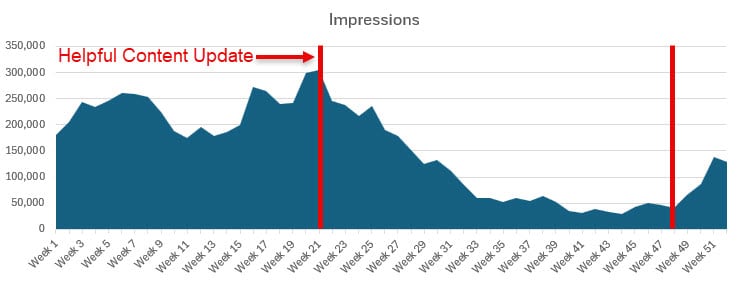Introduction to the Recovery Journey
Full Disclosure: The data I’m going to share with you is for one of my personal websites – Cars and Coffee Events. The website was hit hard by Google’s Helpful Content Update in September, and while the recovery is recent (three weeks and counting), it’s strong and shows no signs of slowing down.
Impact of Google’s Helpful Content Update
Clearly, Google’s Helpful Content Update didn’t affect every website. I’ve got a half dozen SEO clients that breezed through the update without missing a beat. And even for those websites that were affected by Google’s update, it wasn’t always clear. My website – carsandcoffeeevents.com – was one of those.
Analyzing the Drop in Impressions
In most of the US (except possibly in California, Arizona, and Florida) there’s a noticeable seasonality to the number and frequency of events: Colder months have fewer events and warmer months have more events. The website is entirely self-service, and while the number of events added to our calendar starts to increase in March and starts to decrease in November, the peak of the season (when we get 100’s of events added every day) starts with Memorial Day and ends with Labor Day.
In 2023, Labor Day was Monday, September 4th – exactly 2 days before Google released the Helpful Content Update – so when I checked the website’s performance on Google Search Console later that week and saw a drop in organic impressions, I didn’t think anything of it. In fact, the number of impressions the website was getting on Google followed the same pattern that it followed in 2022 and in 2021. Actual impressions were about 25% lower than the previous year, but I attributed that to some issues the website had been having throughout the summer.
Realization of a Deeper Issue
Beginning in October, my developers and I tightened up the security problems that surfaced during the summer, and addressed some additional tech stuff, and completed the work about a week before Thanksgiving. Typically, the worst time of the year for car related events is between Thanksgiving and Christmas, so when I checked Search Console, in early December and didn’t see any deviation from the year-over-year pattern, I wasn’t bothered. In fact, I wasn’t the least bit concerned until after Christmas.
That’s when it was clear that something was wrong.
For the last 2 years, the pattern was to see a drop in organic search impressions until Christmas Day. After the 25th, there would be a gradual increase in impressions until mid-March when the season started. But that wasn’t happening this year. Impressions were down by about 90% from their peak on Labor Day and they were staying there. I started thinking this wasn’t a seasonal problem, and might be a Helpful Content Update problem.
Consultation with an Expert
Why didn’t I consider Google’s update as the problem sooner? A bit of hubris I suppose. The website had been doing really well on Google search because it addressed a specific need in the market: we made available, in one place, a list of over 20,000 events for automotive enthusiasts, organized by date, location, time, and type of event. We had incredible buy-in from the community. People wrote us emails telling us how “helpful” the website was.
Google, obviously, thought differently.
I needed another set of eyes on the data to confirm my analysis. So, right after the 1st of the year, I reached out to someone in the community who’s been doing incredible research and reporting on the industry for years and whose opinion I value and respect: Dr. Marie Haynes.
Diagnosing the Content Issues
Marie (who is incredibly busy) poked around the website for a bit and gave me her assessment: No question about it. Google did NOT find my content particularly helpful. She gave me a list of things to focus on: the website’s speed, the number of pages with thin content, the lack of original content, and the number of 404 errors.
Implementing Technical Fixes
To keep staffing costs low, the website was built to be self-service. A description of the event, the name(s) of the event organizers, the venue where the event is being held are all provided by the person adding the event to the calendar. Our staff reviews all the submissions to make sure they don’t violate any community standards, but that’s about it. We have no control over whether the person submitting the event writes a 10-word description, or a 300-word description. We also have no control over whether the content is unique or whether it is copied from another website (like Facebook) where they have the event listed.
Overhauling Content and SEO Practices
There was also a problem with the calendar software the website used itself. Actually, two: The first problem has to do with the 404 errors. By design, events that have already taken place are deleted from the calendar after 90 days. The software, however, does this automatically and doesn’t create a redirect. So every day, more URLs are removed and the number of 404 errors goes up. And up. And having literally 30K (or more) URLs in Google’s index that are throwing 404 errors would be considered unhelpful.
The solution to this problem was some custom programming. Creating a 301 redirect for each of these events on a one-to-one basis wasn’t practical, so we added some code to the .htaccess file that 301 redirected any inbound request for an event that was over to a custom page that presented a message for Users that the page being requested was over and offered some alternatives. The page is like a custom 404 page, but the 301 redirect sends a message to the search engines to remove the page from the index. Could I have used a custom 410 page instead? Maybe. But I didn’t want to get that deep into changing the calendar plugin’s core functionality.
The second problem had to do with Venues and Event Organizers. When an event is added by a 3rd party, pages are created for the Venue (location) and the Organizer. But because the software doesn’t provide the capability for 3rd parties to add descriptive text, or a Featured Image for either the Venue or the Organizer, the pages it creates don’t have a lot of information on them. They’re essentially empty and in Google’s opinion, unhelpful.
The solution here was much easier: make the pages “invisible.” Every event page displayed the name of the venue and the name of the event organizer, both linked to the respective URLs. Working with the plugin’s developers, we modified the individual event listing php file removing the link to the /venue and /organizer pages. We also excluded any /venue and /organizer pages from the Yoast sitemaps and as a backup, added disallow directives for any pages in those directories to the robots.txt file.
Waiting for Results
On to the performance issues. We addressed the speed problem by adding some additional indexes to the database; we also went through Google’s PageSpeed Insights tool report line by line to fix anything that was called out as problematic. Images were optimized. Javascript and CSS files were minified. Anything that could be served locally was, and anything that couldn’t was examined to see if it was really necessary. I was a pain in the ass to do, but it helped.
And then we waited. And waited. And waited.
For two-and-a-half months, there was no movement. Nothing. Things got so bad, that on March 24th, I sent an email out to the Board letting them know I was closing down the website as of April 1st. And then, two days later, a glimmer of light appeared at the end of the tunnel.
Observing Signs of Recovery
Out of nowhere, organic search impressions started to increase. It wasn’t a big increase at first, but it was enough of an increase so that, when April 1st came, I decided to wait another week (to make sure this wasn’t an April Fool’s joke). And then another. And another.

If you look at the 12-month chart above (from Google Search Console), there is a clear indication that the changes are finally taking hold. Organic search impressions are up and visits to the website have returned to the levels they were at 12 months ago.
Cautious Optimism
Am I willing to declare victory? No, not yet. We have a long way to go before traffic is back to pre-Helpful Content Update levels. I want to see [at least] another month of data before I do that. But I do feel like things are going the right way for the first time in nearly 5 months, and that’s enough for right now.







